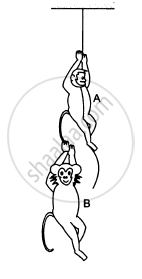Advertisements
Advertisements
Question
What do you mean by the conservation of momentum? Briefly, explain the collision between two bodies and the conservation of momentum.
Solution
Conservation of momentum in case of a collision between two bodies means the total momentum before and after collision remains unchanged or conserved, provided no net force acts on the system.
Consider two bodies A and 8 having masses m1 and m, and initial velocities u1 and u, respectively. The bodies collide head on with each other and their collision lasts for t seconds. Suppose the velocities of A and 8 after collision are v1 and v, respectively. Assume that no external forces are acting on the bodies.
Rate of change of momentum of ball A = m1(v1 - u1)/t .
Rate of change of momentum of ball 8 = m1 (v1 - u1)/t .
If FAB is the force exerted by A on 8 and FBA is the force ex
Rated by 8 on A, we can write
FAB= m1(v1 - u1)/t .
FBA = m1 (v1 - u1)/t .
FAB = -FBA
m1(v1 - u1)/t = - m2(v2- u2)/t .
m1(v1 - u1) = - m2(v2- u2)
m1v1 +m2v2 = m1u1+m2u2
So total momentum after collision = total momentum before collision.
This proves conservation of momentum during collision.
APPEARS IN
RELATED QUESTIONS
A helicopter of mass 1000 kg rises with a vertical acceleration of 15 m s–2. The crew and the passengers weigh 300 kg. Give the magnitude and direction of the
(a) force on the floor by the crew and passengers,
(b) action of the rotor of the helicopter on the surrounding air,
(c) force on the helicopter due to the surrounding air.
A car accelerates on a horizontal road due to the force exerted by.
In the following figure shows a uniform rod of length 30 cm and mass 3.0 kg. The strings shown in the figure are pulled by constant forces of 20 N and 32 N. Find the force exerted by the 20 cm part of the rod on the 10 cm part. All the surfaces are smooth and the strings and the pulleys are light.

In the previous problem, suppose m2 = 2.0 kg and m3 = 3.0 kg. What should be the mass m, so that it remains at rest?
The monkey B, shown in the following figure, is holding on to the tail of monkey A that is climbing up a rope. The masses of monkeys A and B are 5 kg and 2 kg, respectively. If A can tolerate a tension of 30 N in its tail, what force should it apply on the rope in order to carry monkey B with it? Take g = 10 m/s2.

The correct form of Newton's second law is :
A force acts for 10 s on a stationary body of mass 100 kg, after which the force ceases to act. The body moves through a distance of 100 m in the next 5 s. Calculate: The velocity acquired by the body.
Name the physical entity used for quantifying the motion of a body.
State Newton's second law of motion. Is Newton's first law of motion contained in Newton's second law of motion?
What do you mean by an impulsive force?
